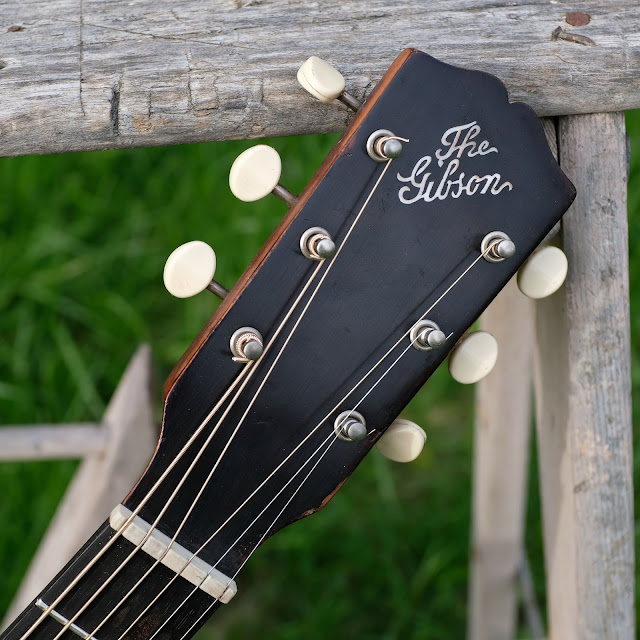1915 Gibson L-1 Carved-Top Archtop Guitar
Teens-era L-1s with their small bodies, round soundholes, and short scale lengths make perfect blues-box fingerpickers. They also make a good, mellower-sounding jazzy three-note chordal instrument or midsy-sounding folk-strummer. The last bit is something that will work on one of these decently (go hunt-up some Tom Waits and Jack White and listen to their L-Jrs) but less-well on latter-era archtops which tend to want a driving, punchy hand to get the most out of them.
So -- it's a cool guitar, sure. It's also beat! This came to me with seams open at the endblock and heel, entirely stripped and refinished half-heartedly, refretted, lacking a bridge fit decently-well to the top, with awful '70s import tuners, half of its fretboard binding gone and the other half with its shelf removed so it couldn't be put back on, and top cracks that'd been sealed but not cleated. My work included righting everything -- I prepped and glued-up the seams as well as I could (these almost always have a little mismatch by the time they're this old), cleated the cracks, leveled/dressed the frets, fit a new ebony bridge to match the ebony fretboard, removed the remaining binding from the board and touched-up both sides of the fretboard so they'd blend into the neck better, replaced the tuners with some '60s American units that look more appropriate, and set it up.
The result is what I described above -- a nice, velvety, open-sounding and mellow carved-top voice. Because the body is small, the bass is just not there, but lower-mids certainly are. These guitars are more fun to play on the lonesome than a "normal" archtop, however, because the sound bleeds to one's ears a bit more than the compressed voice of an f-hole box will.
Specs are: 24 1/4" scale, 1 11/16" nut width, 1 7/16" string spacing at the nut, 2 1/8" spacing at the bridge, 13 5/8" lower bout width, 10" upper bout, and 3 1/4" side depth. The neck is a big-to-giant V-shape and the fretboard has an interesting, ~14" radius to it. Top wood is solid, carved spruce while the back and sides are solid birch with a carved back. The neck is mahogany and both the original fretboard and new bridge are ebony. Action is spot-on at 3/32" EA and 1/16" DGBE at the 12th fret. The neck is straight and strings are gauged 54w, 42w, 32w, 24w, 17, 13 due to the short scale. The top is in good shape save the repaired cracks and the usual flattening/top sink under the bridge you see on these guys. It's stable and hasn't moved after stringing.
As far as the finish goes: someone re-stained it with a dark brown but didn't do an ace job, shall we say. The back, neck, and sides were almost bare of finish when it came in (though I sealed them with wipe-on poly and cleaned them up a little). The top, however, has some sort of satin coat on it that I spruced-up looks-wise a bit.
The tailpiece is not original but it is an older '30s-era unit from what I can tell. I added retro-looking strap buttons at the heel and tailpiece area, too.
The frets are newer medium stock and feel good -- with plenty of life left in them.
Here are the (now-repaired) hairline cracks on the top.
There are a few very minor hairline cracks (repaired) on the sides, but that's it for the sides and back.
The 3007 factory order number places this one at 1915.






















Comments
Best wishes